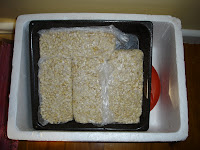
Tapioca commonly known as ubi kayu in the Malay language and 木薯 (mushu)in Chinese. In both languages, it is aptly named because of its woody appearance. It is primarily grown in many Pacific Island countries and also in many parts of Asia, including Indonesia. In Papua New Guinea, the plant is grown for its edible tubers, which serve as a staple food in many parts of the country. The majority of frozen tapioca found in many Asian grocery stores is imported into Australia from Pacific Island countries such as Fiji and Tonga. Historically, its value as a famine relief crop has long been recognized. In many parts of South East Asia during the Second World War many people survived on tapioca roots. But on other hand, it has been reported that raw tapioca or unprocessed tapioca can be a potential public health and safety risk due to the presence of cyanogenic glycosides in the raw or unprocessed tapioca. This can lead to exposure to hydrogen cyanide and its related toxicity.
Is tapioca safe to eat? Tapioca is safe to eat providing that it is prepared properly. It can be made safe to eat by first peeling and slicing the tapioca and then cooking it thoroughly either by baking, boiling or roasting. Frozen tapioca should also be prepared in this way. Furthermore, the majority of raw or unprocessed tapioca imported into Australia and New Zealand comes from a variety known as sweet cassava which is normally low in cyanide content. Here is a tapioca pudding recipe that has been consumed traditionally in both Singapore and Malaysia and has a long history of safe consumption.
Incidentally it has just won a cooking prize at my workplace!

Chiu Chu Kuih aka Tapioca Baked Pudding Recipe.
1kg fresh tapioca, peeled and grated, if unavailable, use frozen grated tapioca
385 ml thick coconut cream
1/2 tsp salt
1 1/2 cup sugar
2 eggs beaten
2 tbsp tapioca flour or corn flour.
2 tbsp butter
Grease a 20cmx30cm (8"x12") square tray with butter. Mix all ingredients in a large bowl and stir with a long wooden spoon. Pour mixture into the baking tray. Bake in a preheated oven at 180 C for 35 to 45 minutes or until set. Put under a grill for 15 minutes or until the crust is golden brown. Leave to cool for at least 6 hours before cutting to serve.





